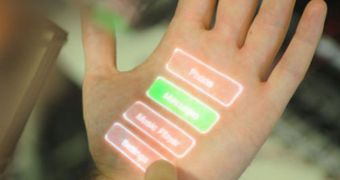It has almost become the norm in science-fiction movies that touchscreen interfaces are the way of the future. All cosmic ships and exoplanetary bases have them, and many people believe that they will dominate the world of tomorrow. But experts at Carnegie Mellon University and Microsoft seem to think different. They argue that the final frontier in tactile interface is our own body, and have developed the “Skinput” system to prove it. The new system was recently unveiled, and its functionality is unlike that of any other device on the market today, LiveScience reports.
Though it may seem complicated to turn your entire body into an interface, this is not that difficult to pull off, the experts say. They reveal that their system relies on capturing and deciphering vibrations. That is to say, depending on where a user taps on his or her arm, a different type of vibration is produced, that is picked up by an armband outfitted with sensors. This approach is a definite improvement from other tracking methods, which for instance relied on motion-tracking to figure out where a user taps on their arm.
Depending on the pressure applied, and the spot where it is applied, the new system analyzes the shape of the hand, tendons and muscles, all of which is extremely important for how vibrations propagate. Once this is achieved, the armband can easily figure out where the user tapped on their arm exactly. ”Accuracy is already good, in the high 90s percent accuracy for finger input. The arm band is a crude prototype. The next generation could be made considerably smaller – likely easily fitting into a wristwatch,” says CMU Human-Computer Interaction Institute project team member Chris Harrison.
The group reveals that controlling electronics could become very easy once the tracking system is properly researched. The locations on which people tap could be associated with various commands, in a manner similar to how keyboards and mice work on computers. By hooking up the sensor to a small projector, the researchers could create small displays on the skin, thus allowing the users to use menus and scroll through features. The new approach to interacting with electronics is only a proof-of-concept at this time, but experts hope to put the new technology into production soon.

 14 DAY TRIAL //
14 DAY TRIAL //